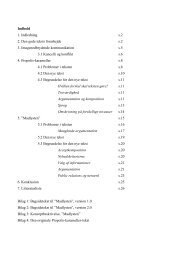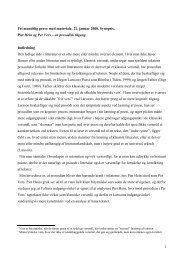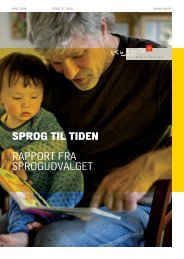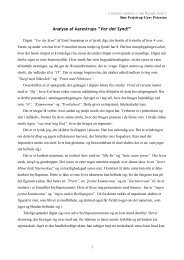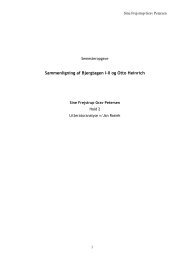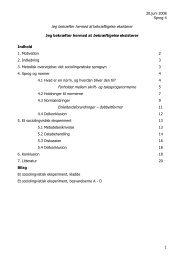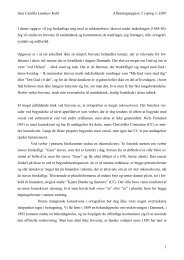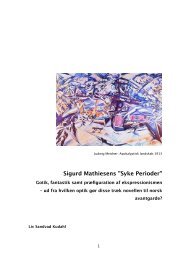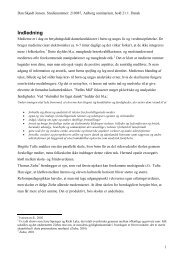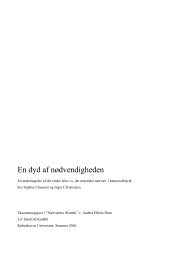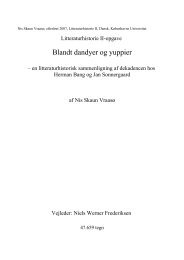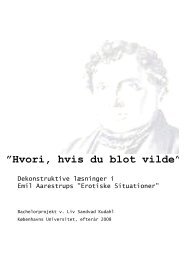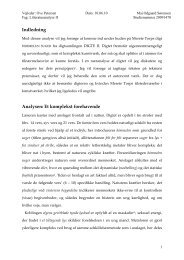Et kysk og forvovent Borgerbarn” – Claussens ærbare ... - Dansk.dk
Et kysk og forvovent Borgerbarn” – Claussens ærbare ... - Dansk.dk
Et kysk og forvovent Borgerbarn” – Claussens ærbare ... - Dansk.dk
You also want an ePaper? Increase the reach of your titles
YUMPU automatically turns print PDFs into web optimized ePapers that Google loves.
Abstract<br />
Reading through Sophus Claussen’s writings it becomes obvious that most of his writing<br />
activities are circulating around women. With a bit of knowledge of the writer’s<br />
bi<strong>og</strong>raphy it also becomes clear that most of these writings about women stem from<br />
experiences in Claussen’s own life, because of which it cannot be read and analysed<br />
without taking notice of his real-‐life experiences with women in the Danish society<br />
around the turn of the previous century.<br />
The images of women in Claussen’s work can be categorized into three different kinds.<br />
Firstly we have the respectable women who are fascinating Claussen time after time, but<br />
who are also bound by society’s conventions on women’s sexual behaviour. The erotic<br />
unapproachableness that he discovers with these decent young women is expressed by<br />
a number of female characters that are no longer “real” women from Claussen’s life but<br />
instead mythol<strong>og</strong>ical, erotic and warm. These goddesses follow their own will and<br />
wisdom and are therefore symbols of the criticism Claussen had against society. They<br />
represent the norms that Claussen himself whished to live by, and with them comes also<br />
a shift in genre <strong>–</strong> with the mythol<strong>og</strong>ical women the author goes from what could be<br />
called “classical” poetry to writings of a more symbolist kind which is used when<br />
Claussen cannot enunciate his statements in referents from the earthly/daily world<br />
anymore.<br />
And Claussen’s dissatisfaction with society only seems to grow: after having lined up<br />
the goddesses he is seeking downwards against hell where he devotes his writings to<br />
women of demonic kinds. These demons range from prostitutes to queens but possess<br />
one similarity: they are all in the power of their sexual instinct <strong>–</strong> and they urge others to<br />
be the same.<br />
To find a real-‐life woman who fulfils this way of thinking and behaving must have<br />
seemed hard during Claussen’s time. Nonetheless he found such a woman, and the<br />
Italian Signora Clara with whom he fell in love on one of his travels is described as the<br />
very ideal of female nature. Containing both decent and beautiful looks and a very liberal<br />
sexuality she captured Claussen (or Silvio, as the narrator in the partly autobi<strong>og</strong>raphical<br />
novel Valfart is called), but for no more than a few months <strong>–</strong> after having been healed by<br />
the love of Clara he dedicates himself completely to writing as he realises that the erotic<br />
powers from within can be canalised into creativity.<br />
What I concentrate on in this assignment is therefore the sublimation that Claussen<br />
26



